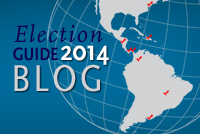Poll Update: Brazil's President Faces Narrower Margin as Silva Gains Momentum
After taking over for her party in the wake of Eduardo Campos’ death, Marina Silva moved into second place in the polls.
 A little more than a month remains before Brazil’s October 5 presidential vote, when President Dilma Rousseff will seek a second term against increasing competition. She faces two main contenders: former Environment Minister Marina Silva and Senator Aécio Neves. Silva, originally a vice presidential pick, took over her party’s candidacy after candidate Eduardo Campos died in a plane crash in mid-August. The third-place candidate during the 2010 presidential election, Silva is now gaining in the polls.
A little more than a month remains before Brazil’s October 5 presidential vote, when President Dilma Rousseff will seek a second term against increasing competition. She faces two main contenders: former Environment Minister Marina Silva and Senator Aécio Neves. Silva, originally a vice presidential pick, took over her party’s candidacy after candidate Eduardo Campos died in a plane crash in mid-August. The third-place candidate during the 2010 presidential election, Silva is now gaining in the polls.
In recent weeks, Rousseff saw her lead narrow. An August 26 Ibope poll put Rousseff in first with 34 percent, followed by Silva with 29 percent and Neves with 19 percent. In a second round, Silva would win against Rousseff by a nine-point margin. An August 29 Datafolha poll showed Rousseff and Silva tied with 34 percent, with Neves at 15 percent. This survey indicated Silva would win in a second round with 50 percent of the vote, compared to 40 percent for the president. The change is notable; back in April, Ibope showed Rousseff winning in the first round.
In São Paulo and Rio de Janeiro—which encompass nearly a third of the electorate—Silva is also in the lead. This week, a local Ibope poll in those two states found that the former environment minister has 38 percent in Rio and 39 percent in São Paulo, compared to 32 percent and 23 percent for Rousseff, respectively.
Another Ibope poll—this one on a national level—reveals Rousseff still in first place, but only by 4 points—in a survey with a 2 percentage-point margin of error. The September 3 poll showed Rousseff at 37 percent, with Silva at 33 percent and Neves at 15 percent. It also indicated Silva would win in a runoff against Rousseff by 7 points.
Similarly, a new Datafolha poll released September 3 shows the president at 35 percent, Silva at 34 percent, and Neves at 14 percent. It also pointed to a close runoff, with Silva winning by 7 percentage points.
According to Datafolha, Rousseff draws the highest levels of support from those 45 and older, those who have an elementary-school education, and those who earn up to two minimum wages per month. Silva, meanwhile, has the highest levels of support among those aged 16 to 34, those who have a college degree, and those who earn middle-class salaries. Rousseff has higher support among Catholics, while Silva has more backing from evangelicals. Regionally, Rousseff enjoys larger levels of support in the North and Northeast, and Silva draws greater support in the Southeast.
Candidates are in the final part of the race that includes daily TV and radio ads, as well as a number of TV appearances. In August, the presidential hopefuls appeared in one-on-one interviews on TV Globo’s Jornal Nacional, and they faced off in a first televised debate on August 26. On September 1, the candidates participated in a second debate, with a focus on economic policy, corruption, security, and social issues such as LGBT rights and abortion. This month, a new series of interviews will take place on TV Globo, though Rousseff declined her invitation this week to the Jornal da Globo program.






